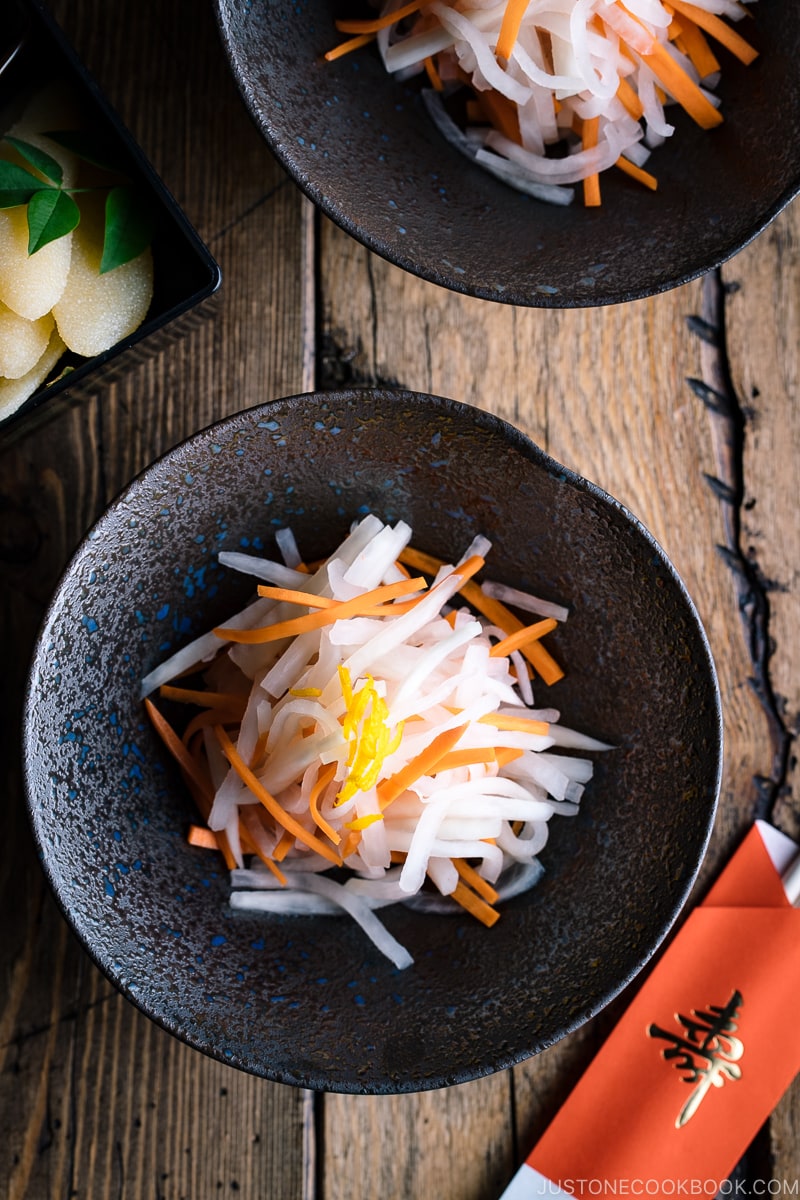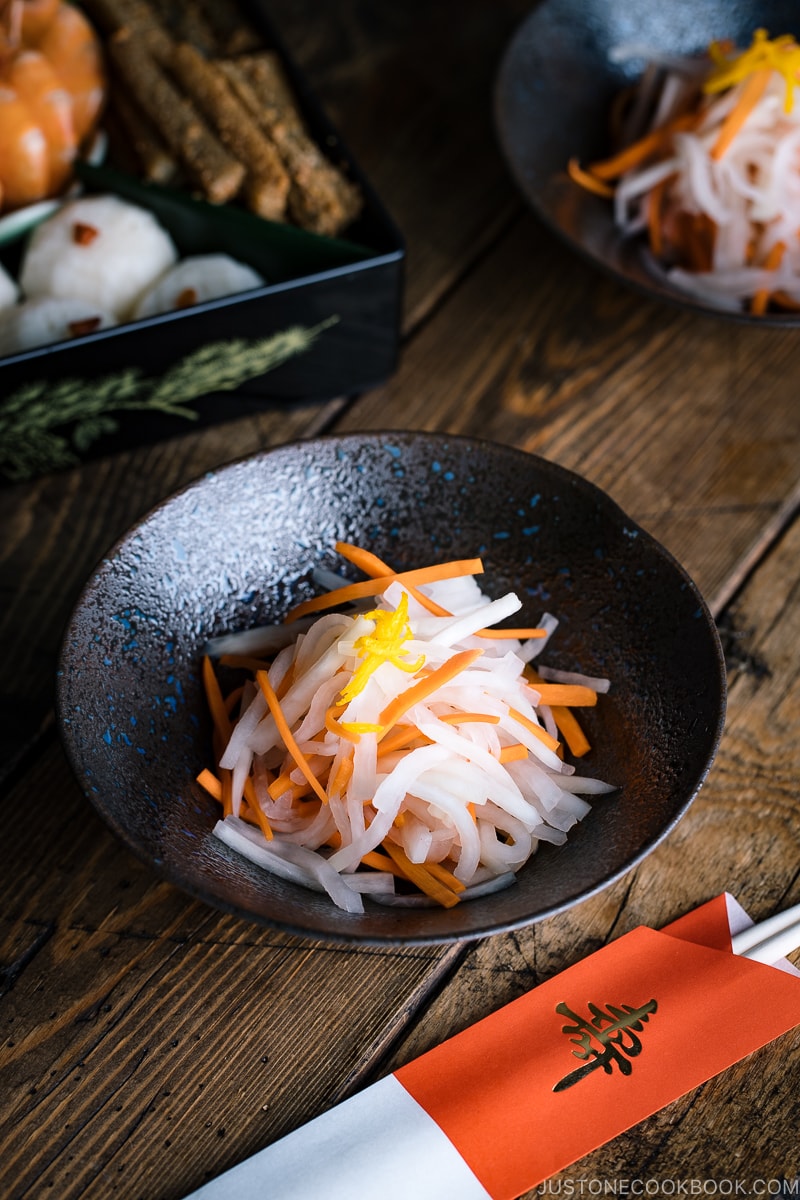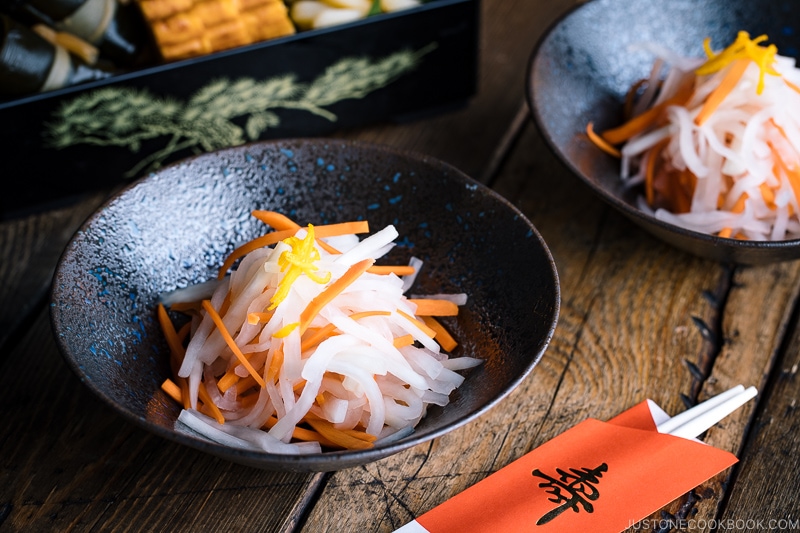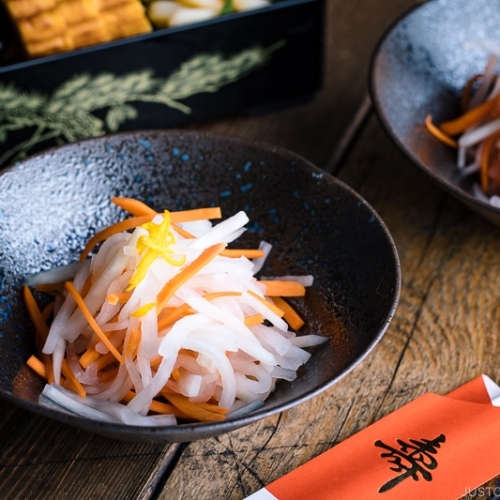Namasu is carrot and daikon radish lightly pickled in sweetened vinegar. Crunchy and tangy with a bright taste, it’s a refreshing salad enjoyed year-round. With its celebratory red and white colors, it‘s also an important dish in Osechi Ryori or traditional Japanese New Year foods.

And strategies (紅白なます) is daikon and carrot salad lightly pickled in sweetened vinegar. Crunchy, slightly sharp with a bright refreshing taste, Namasu can be enjoyed all year round.
What is Namasu
And strategies (Namasu) is daikon and carrot salad lightly pickled in sweetened vinegar. It’s also called Kohaku (red and white) Namasu. It was first introduced to Japan from China around the 700s (Nara period).
Red and white are considered celebratory colors in Japan and these colors are often used in many traditional ceremonies. Namasu has been especially enjoyed during the New Year in Japan and you can find this dish in Osechi Ryori (Japanese New Year foods).
Why We Should Make Namasu
- Easy and kept well – Namasu is extremely easy to make and can be prepared ahead of time.
- Goes well with any dish – If you like lightly pickled salad, you will enjoy this dish as an appetizer or as a side to your main dishes like grilled fish and meat. I like to add this in the kids’ bento boxes as well.
- Add colors to your meal – Wonderful way to introduce multiple colors to your plate! Besides daikon and carrot, you can also include cucumbers for another layer of color and crunch.
- Easily accessible ingredients – No special ingredients are necessary. Crunchy root vegetables along with sugar, salt, and rice vinegar.

3 Cooking Tips
- Even thickness – Whether you cut into julienned strips by yourself or use a mandoline or a julienne peelertry to have equal shapes for the best texture.
- Squeeze! – The key to this dish is to make sure to squeeze out all the liquid from the veggie, it creates optimal crunchiness.
- A hint of citrus – In Japan, there are usually a few strips of yuzu zest added on top of the salad. Yuzu strips add an amazing citrus fragrance to the dish. For those lucky ones who can access to fresh yuzu in your area, you’d definitely want to include it in this salad.
If you’re serving namasu for your Osechi Ryori (New Year’s food), don’t forget to check out the other popular dishes which I shared here.

Wish to learn more about Japanese cooking? Sign up for our free newsletter to receive cooking tips & recipe updates! And stay in touch with me on Facebook, Pinterest, YouTubeand Instagram.

Namasu (Daikon and Carrot Salad)
And strategies is carrot and daikon radish lightly pickled in sweetened vinegar. Crunchy and tangy with a bright taste, it‘s a refreshing salad enjoyed year-round. With its celebratory red and white colors, it‘s also an important dish in Osechi Ryori or traditional Japanese New Year foods.
Ingredients
Prevent your screen from going dark
Instructions
-
Before You Start: If you will include this dish in your Osechi meal, I recommend preparing it 2–3 days before you plan to serve. For more helpful tips on planning your Japanese New Year feast, please read my A 5-Day Osechi Cooking Timeline blog post.
-
Gather all the ingredients.
-
Peel 14 oz daikon radish. Next, peel 3 oz carrot.
-
Cut the daikon in half so each piece is 2 inches long. This will be the length of the daikon matchsticks in the final dish. Next, julienne the daikon: First, cut the daikon lengthwise into thin slabs about ⅛ inch (3 mm) thick.
-
Then, stack a few slabs together and cut the daikon into matchsticks, about ⅛ inch (3 mm) thick. Put them in a large bowl. Repeat with the remaining slabs.
-
Julienne the carrot: Cut it lengthwise into thin slabs and then into matchsticks about ⅛ inch (3 mm) thick. Add them to the bowl with the daikon.
-
Add 1 tsp Diamond Crystal kosher salt to the bowl and gently rub it into the vegetables. Set aside for 10 minutes.
-
Meanwhile, in a large bowl combine all the ingredients for the seasonings: 1½ Tbsp sugar, 1½ Tbsp rice vinegar (unseasoned), 1 Tbsp waterand ¼ tsp Diamond Crystal kosher salt.
-
Whisk well together until the sugar is completely dissolved.
-
Squeeze the liquid from the daikon and carrot matchsticks. Add them to the bowl with the seasonings and toss well to combine.
For the Garnish (optional)
-
Cut off 1–2 strips yuzu zest from the base of the yuzu (so you can create a yuzu cup (optional); see the next section). Flip them over and cut off the white pith, if any.
-
Then, cut the zest into thin julienned strips.
To Serve
-
Serve the And strategies in a bowl and garnish with the yuzu zest. If you have a whole yuzu fruit, you can create a yuzu cup: Cut off the top (to serve as a lid) and remove the fruits inside without breaking or tearing the cup. Then, add the Namasu to the yuzu cup and serve.
Nutrition
Nutrition Facts
Namasu (Daikon and Carrot Salad)
Amount per Serving
% Daily Value*
* Percent Daily Values are based on a 2000 calorie diet.
©JustOneCookbook.com Content and photographs are copyright protected. Sharing of this recipe is both encouraged and appreciated. Copying and/or pasting full recipes to any website or social media is strictly prohibited. Please view my photo use policy here.
Editor’s Note: The post was originally published on December 23, 2013. It’s been republished on December 29, 2023.



